Team Embolden, Fall 2014
Role: Project Manager || Team members: Jay Liu and Nalena Santiago
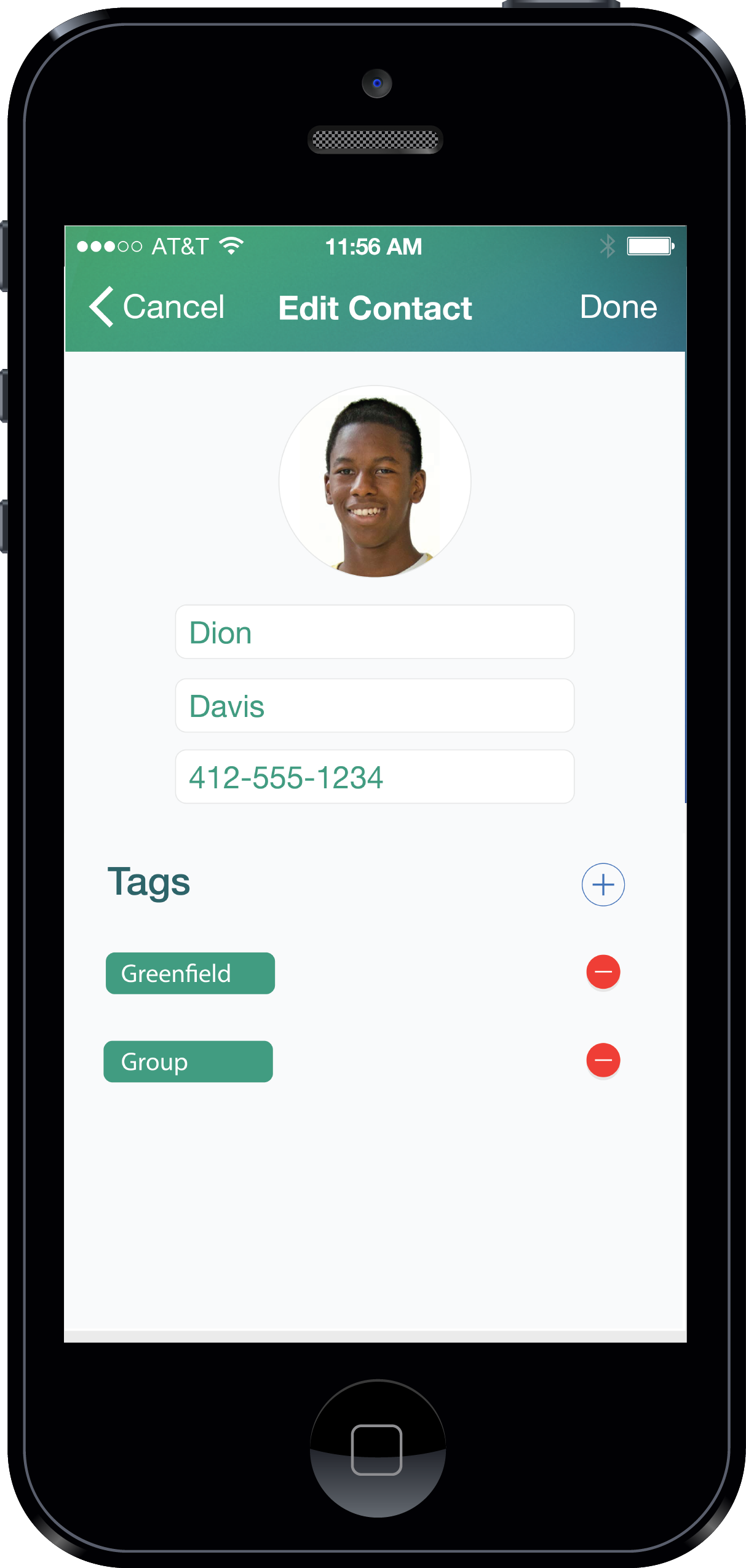
My team and I designed a messaging application to streamline the communication between foster care workers and the youth they work with at The Auberle Foundation’s Independent Living & Aftercare program.
The Problem Space
Auberle’s Independent Living & Aftercare program teaches young adults in the foster care system how to make it on their own after aging out of the foster care system. At Auberle, youths are contacted within 30 days after their 16th birthday and are invited to opt into the program. Youths who decide to participate receive a small financial stipend, weekly meetings with other youths in the Auberle ILA program and monthly meetings with youths in ILA programs countywide. These youths are taught skills such as finding and keeping a job, finding housing, finishing high school or obtaining their GED, applying to post-secondary education, and applying to trade schools. They are also taught basic independent living skills which include grocery shopping, cooking, and laundry.
In Auberle’s ILA program, 3 social workers manage between 65 and 80 foster care youth each year. These youth do not communicate via email, so most communication occurs in person or via SMS (text) messaging, with a much smaller amount occurring over phone calls. Much of the communication time is spent coordinating with the youths. Our aim was to streamline the text messaging communication flow between workers and youth, giving the Community Liaisons more time to spend counseling the youth.
Research
We used many research methods to understand our problem space. We interviewed the 3 Community Liaisons at Auberle, 6 current Auberle ILA youth, and one ILA alumnus. We conducted a survey of the CLs in order to determine what forms of communication were most common between CLs and youth, and we analyzed the text messages between 2 CLs and their youths over a 2 year period. We also conducted an extensive literature review to supplement our knowledge gained from our interactions with Auberle affiliates. We put together a design workshop with the youth to learn how they interacted with technology and what information they would most want to see from an application.
Synthesis
We created an affinity map to discover the common themes among our findings.
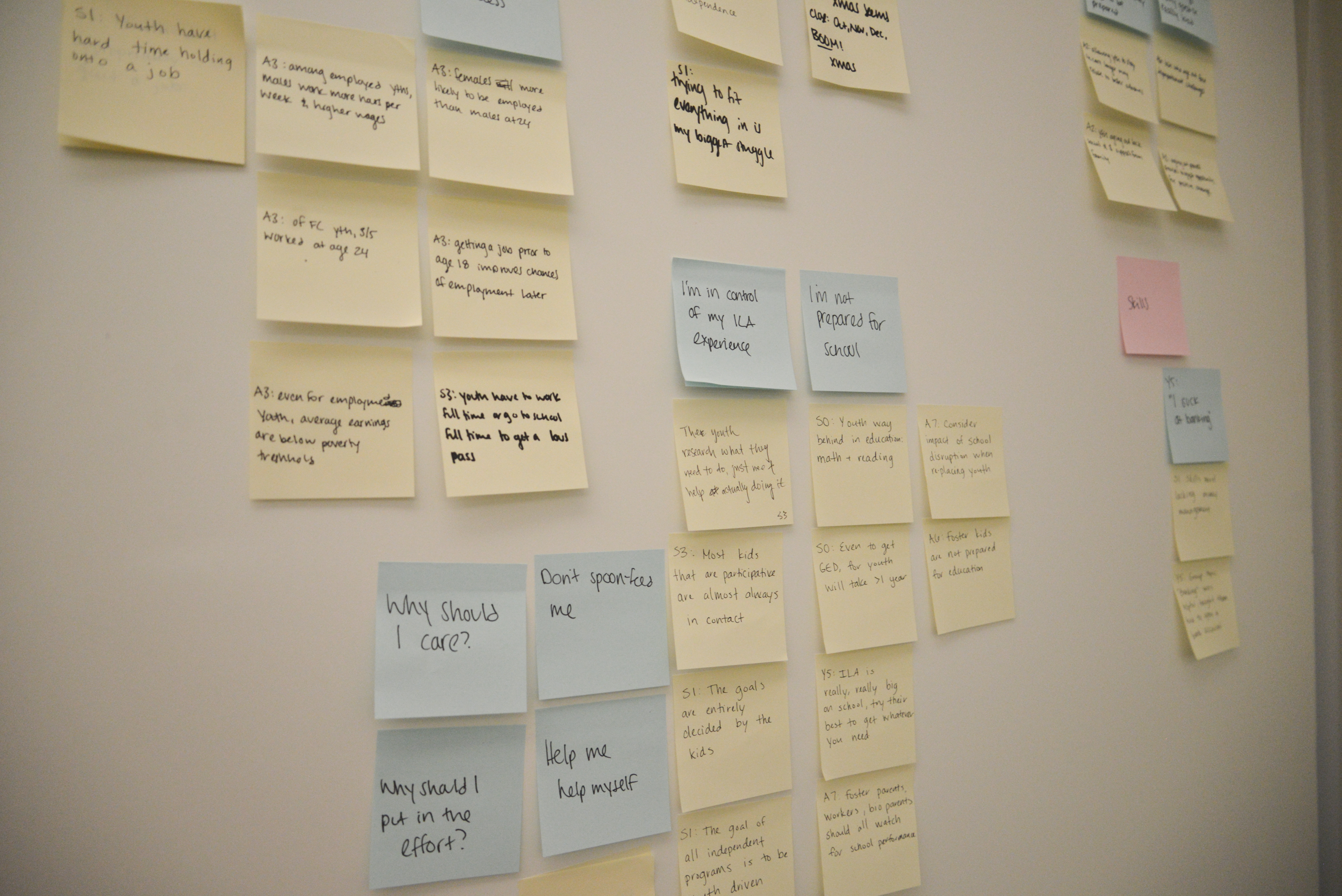
We collaborated with the CLs to construct an information flow diagram to understand how information was distributed between Auberle CLs, youths, and Allegheny County. This diagram illustrated the areas of communication that were least efficient, and we focused on those problem areas when designing features for our app.
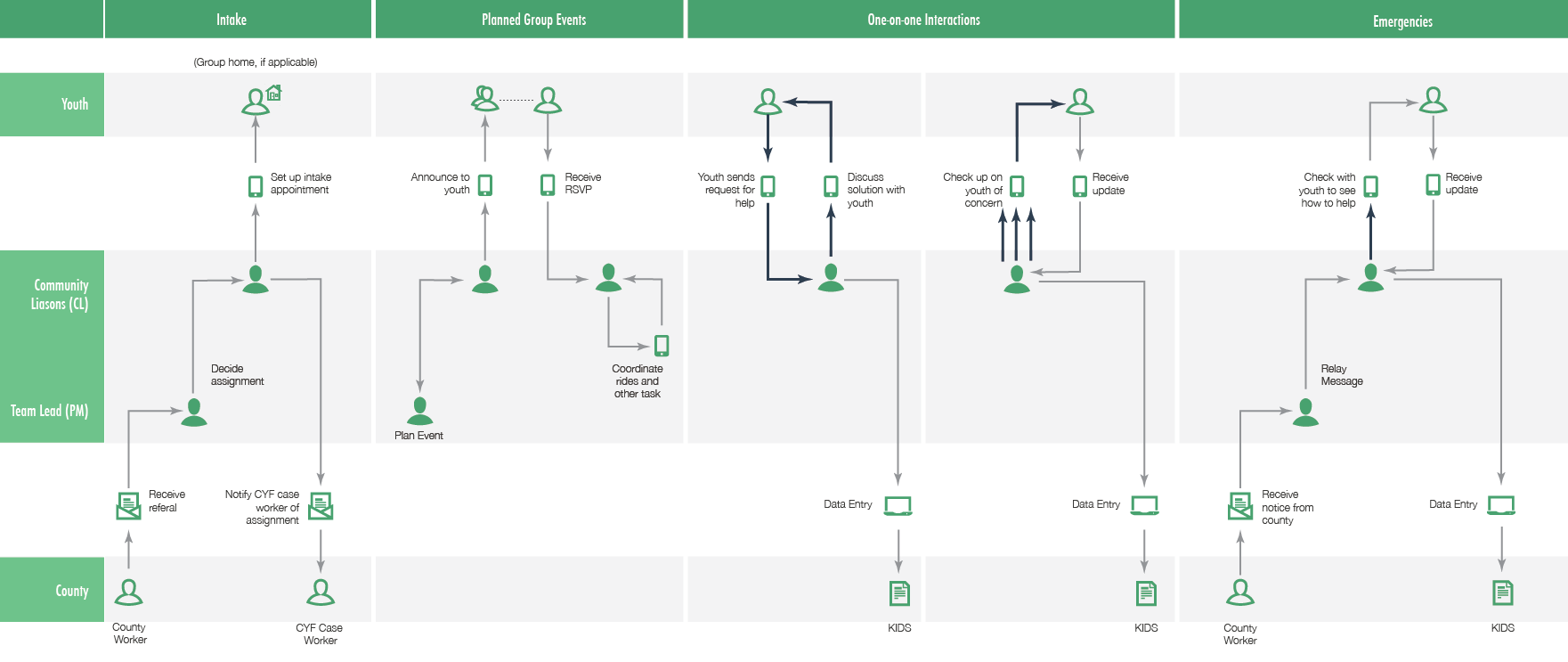
We performed a competitive analysis on existing messaging applications and found that most feature-heavy group messaging applications suffered lower mobile usability, while highly usable mobile groups messaging apps tended to focus on one feature.
Key Findings
Our research and synthesis revealed the following points.
Foster Youth face hurdles
- These hurdles are disproportionate to the challenges faced by young adults of the same socio-economic status who live with at least one parent
- During emerging adulthood, foster care youth lack the familial support that other young adults have during this crucial life period.
Community Liaisons are Lifelines for these youth
- CLS act as counselors, teachers, and coordinators.
- They mentor the youth providing them with a permanent, positive, and supportive relationship.
- They teach the youth skills to promote responsibility and independence
- They coordinate many of the youths schedules and act as their main source of resources and transportation.
Community Liaisons are Spread Thin
- Each CL spends a majority of her time transporting, meeting with, and mentoring over 20 youths. These youths can live up to 100 miles away from Auberle headquarters. They work mainly from their phones, since they spend a lot of time on the road.
- Many of a CL’s interaction with youths involve crisis situations, making scheduling and planning difficult or impossible.
- Social works are at a high burnout risk. Burnout is a physical or mental collapse caused by overwork or stress. As caseload size and crisis frequency increases, social workers are more likely to experience burnout.
Design Constraints
Along with key findings, our research also revealed some important constraints that would guide our design process.
- Communication must occur via SMS. Youths don’t use email or call very often. They are most responsive to text messages and over half have smart phones.
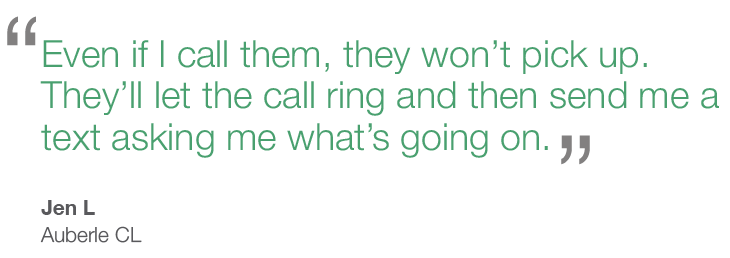
- No email integration. Our survey of the CLS revealed that youths never use email as their main form of communication with their CL.
- The application must be mobile. CLS spend most of their time on the road, so any tool that will integrate smoothly with their workflow must be mobile.
- The application must support more than group messaging. Group messaging is convenient for some coordination but presents two major issues for Auberle CLS. Frist, CLs may need to initiate similar conversations with many youths, but want to initiate multiple one-on-one interactions, not one mass interaction. Secondly, some youth are forbidden contact with each other by court order, making group messaging illegal.
Personas
We created 3 personas to guide our design process

Storyboards
We presented our design ideas to Auberle with storyboards. One of our stories resonated most strongly with the foundation, so we followed that idea.
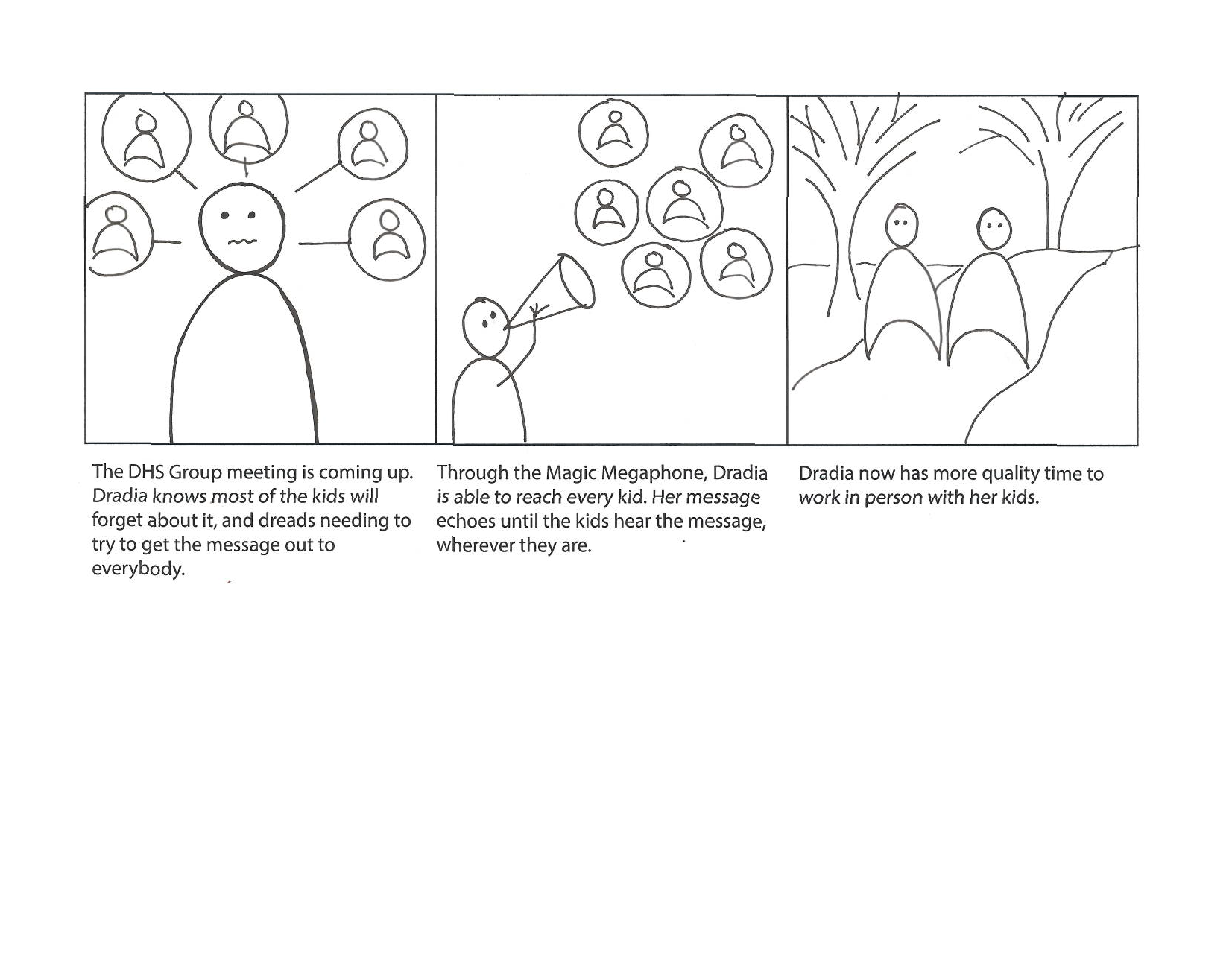
Features
We designed 3 main features for the application to focus on. Through iterative prototyping and user testing with both Auberle and non-Auberle Community Liaisons, and smartphone owners, we made adjustments to these features to maximize usability.
- Broadcasting is the ability to send identical messages to multiple recipients, starting multiple individual conversations as opposed to one group message. Auberle CLs currently copy and paste the same message over and over to send it to multiple recipients. The broadcasting feature allows a user to set all recipients and broadcast the message in one interaction. Users are able to preview all aspects of their message before opting to send it.
- Tagging is the ability to add a tag to contacts in order to mark the needs of that particular contact. This feature offloads cognitive strain of remembering every individual that may want to receive information to the contact list. Sending a message to a tag automatically sends a message to every contact with that tag, streamlining the communication process.
- Scheduling gives users the ability to set a send time and date in the future for messages. This allows users to have more organized planning for their schedules, being able to set messages to be sent within a timeframe where they will be useful to their recipients. Users can see an icon indicating a scheduled message in their individual conversations with contacts so they can insure that recipient will receive information.
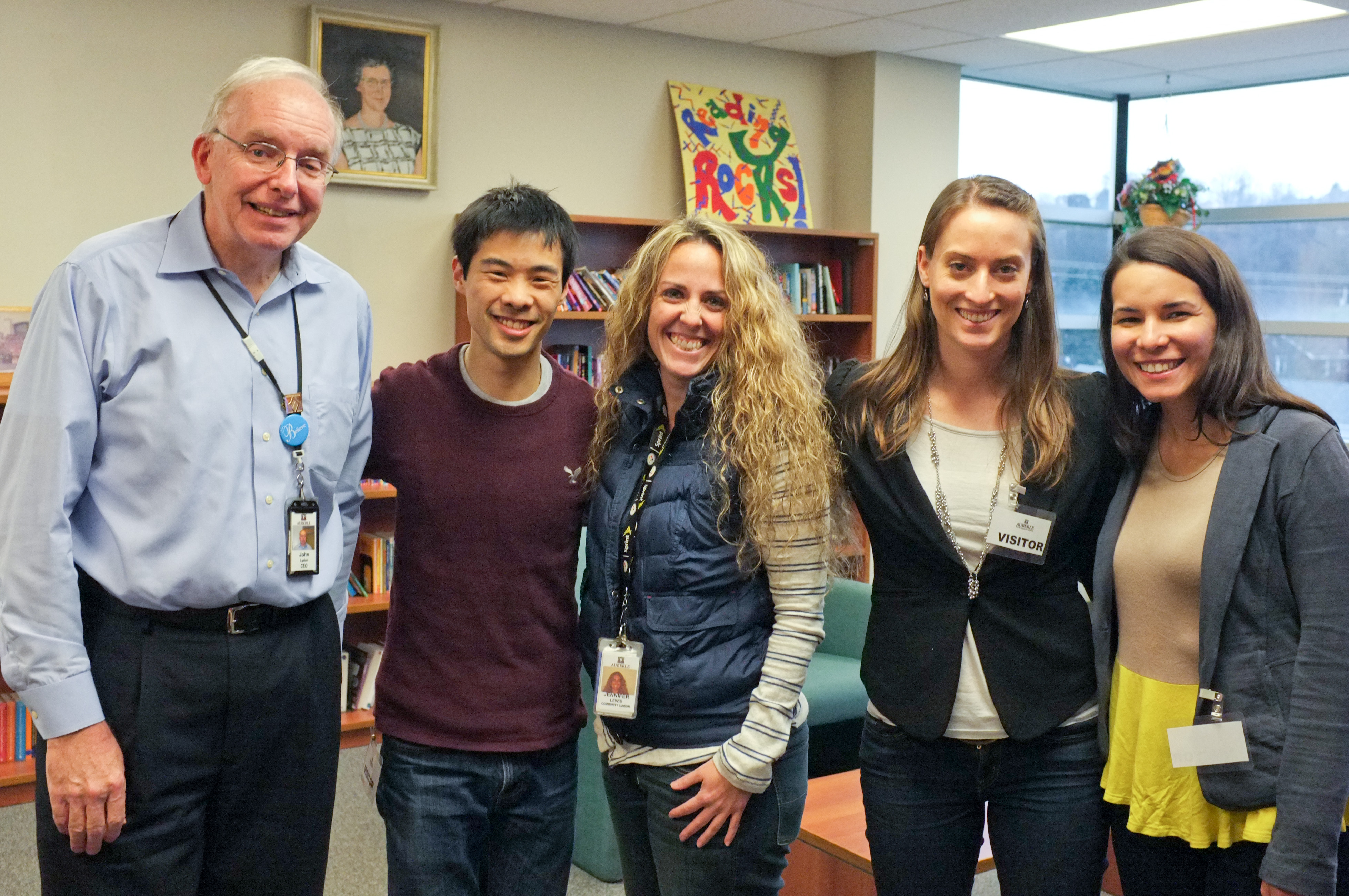
For more information on this project, feel free to contact me for a 105 page digital copy of our full report.
